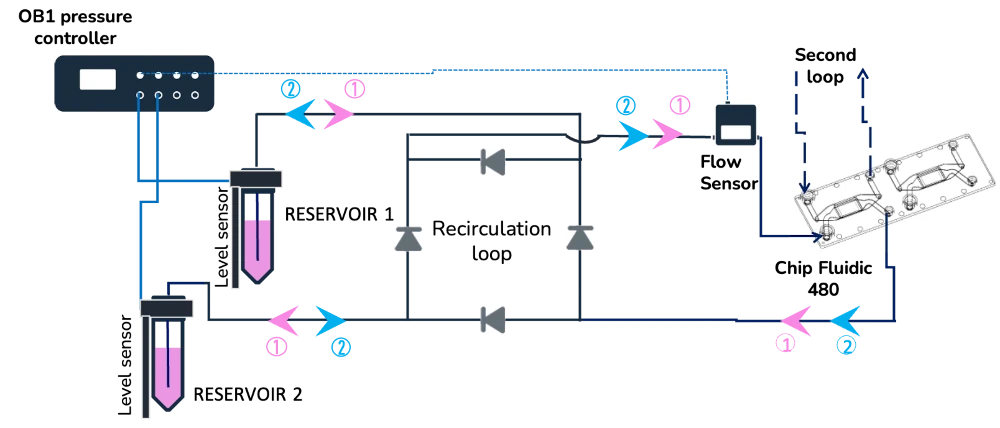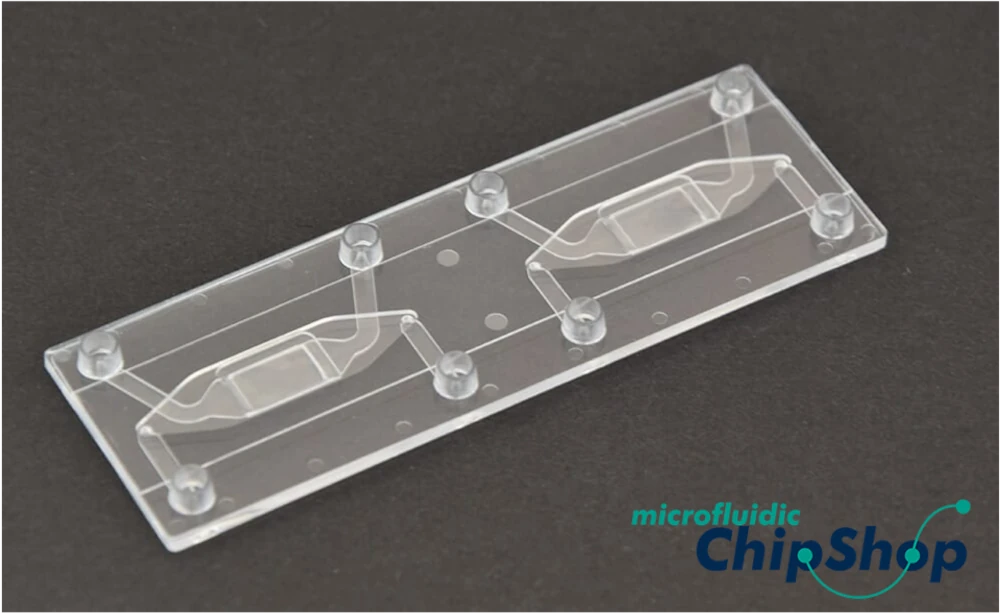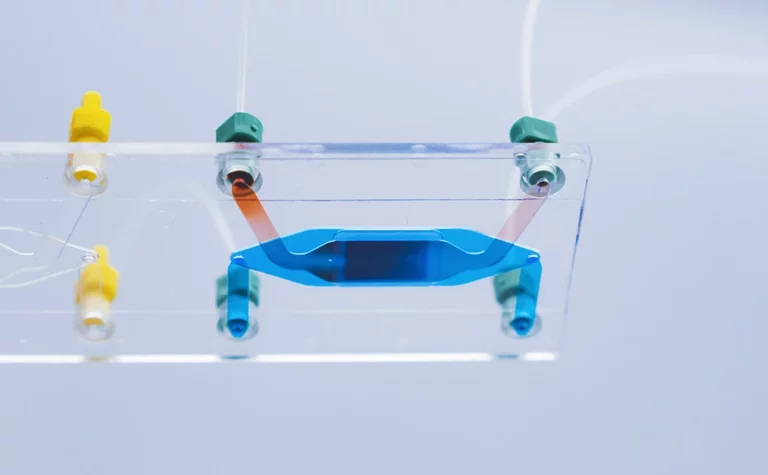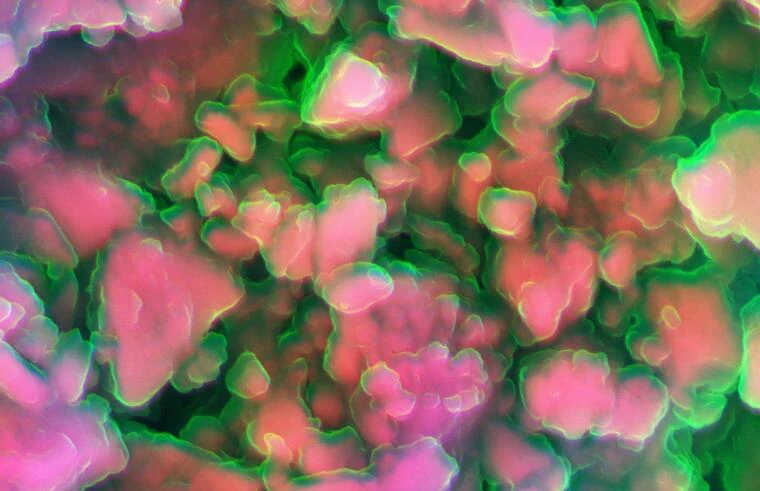Image Credit: Kidney proximal tubule. David Gregory & Debbie Marshall. Licence: Attribution 4.0 International (CC BY 4.0)
KIDNEY-ON-A-CHIP
High control of flow rates to induce cell polarization
Mimic the proximal, distal tubules and/or glomerulus on chip
Circulate media to collect molecules and assess cellular response
Kidney-on-a-chip pack setup
Different areas of the kidney have been reproduced on-chip, such as proximal [1] and distal tubules [2], the glomerulus [3, 4], or the nephron [5]. Our setup allows you to use a single design to work with the model(s) most adapted to your application.
The unidirectional cellular perfusion module, connected to the reservoirs, provides media to the chip in a controlled and automated manner. As the schematic exemplifies, when working with a barrier model with a membrane chip, each chamber’s flow rate and direction can be chosen to reproduce the in vivo reality better.

The kidney-on-a-chip pack includes:
- OB1 flow controller (Elveflow)
- Flow sensors (Elveflow)
- Several Falcon reservoirs
- Unidirectional cellular perfusion module
- Tubings and fittings
- Smart cell culture rack
- Microfluidic chip of your choice (Suggestion: Microfluidic ChipShop Fluidic 480)
- ESI Software (Elveflow)
- User guide
References
- Ng CP, Zhuang Y, Lin AWH, Teo JCM. A fibrin-based tissue-engineered renal proximal tubule for bioartificial kidney devices: development, characterization and in vitro transport study. Int J Tissue Eng. 2013; article ID 319476.
- Ferrell N, Ricci KB, Groszek J, et al. Albumin handling by renal tubular epithelial cells in a microfluidic bioreactor. Biotechnol Bioeng. 2012;109:797–803
- Musah S, Mammoto A, Ferrante TC, et al. Mature induced-pluripotentstem-cell-derived human podocytes reconstitute kidney glomerular-capillary-wall function on a chip. Nat Biomed Eng. 2017;1. article number: 0069.
- Zhou M, Zhang X, Wen X, et al. Development of a functional glomerulus at the organ level on a chip to mimic hypertensive nephropathy. Sci Rep. 2016;6:31771
- Weinberg E, Kaazempur-Mofrad M, Borenstein J. Concept and computational design for a bioartificial nephron-on-a-chip. Int J Artif Organs. 2008;31:508.
A little more about the suggested chip: Fluidic 480
The fluidic 480 cross-flow membrane chip from Microfluidic ChipShop represents a microfluidic chip system for adherent cell culture and, thus, the generation of diverse cellular tissues and organoids. Cell cultivation takes place on the integrated membrane.
The device comprises two in- and outlet ports above and below the membrane that allow molecule transfer. Different pore sizes, materials, and chip geometries with more inlets are also available.

- Suitable for metabolic studies, cell co-cultures, and organ-on-chip experiments
- Compartments divided by a permeable membrane
- Membrane pores from 8 to 0.2 µm
- Chip available in TOPAS or PS
- Interaction area of 36mm2
- Connectors: mini luer
- Upper chamber internal volume: 87.5 µl
- Bottom chamber lower volume: 61.5 µl
Other compatible chips include Fluidic 568 and Fluidic 846.
Compatibility of kidney-on-a-chip pack
Our kidney-on-a-chip pack was designed to be compatible with commercially available or homemade chips (specific adaptors might be required) and the most common supernatant assays. If you have a particular chip or assay not listed, don’t hesitate to contact us!
Chips
- Microfluidic ChipShop
- Homemade devices, PDMS, PMMA, etc.
- Ibidi
- Synvivo
- and more!

Assays
- TEER
- Albumin reabsorption
- Immunochemistry analysis
- Pharmacokinetics assays
- Toxicity assays
- and more!
Kidney-on-a-chip applications
1. ADME analysis: The kidney-on-a-chip model can be part of a drug’s absorption, distribution, metabolism, and excretion simulation system for a better understanding of drug influence in each organ.
2. Physiology modeling: Replicating the kidney microenvironment in vitro allows a deeper understanding of biological processes related to human physiology.
3. Disease modeling: A better understanding of the underlying mechanisms of diseases can be achieved with more apt models, such as the different versions of the kidney-on-a-chip.
4. Preclinical testing: The most powerful argument for using on-chip models is the possibility of using them to test the safety and efficacy of new drugs before they are tested in humans. This could reduce the number of animals used in preclinical testing and improve drug testing accuracy.

Customize your pack
We offer compatible instruments for standard commercialized chips from various brands. We can customize your pack to suit your specific needs with guidance from our specialists, who will suggest the best instruments and accessories. We’ll also help you set up the perfusion platform.
– Check our other Packs for various applications –
Can I order a pack?
Since Packs are products that are still being developed, we have a few eligibility criteria to maximize their success rate. A discussion with our experts is needed to determine your specific needs to offer you a personalized response.
Can the modules be sterilized/autoclaved?
Yes, we have developed a simple protocol for sterilization and cleaning that is provided along with the user guide.
Can a pack be customized based on my specific application?
Yes! Our experts will establish which instruments are best suited for your application, such as the type of flow sensor or the number of flow controller channels you need to perform your experiment. Drop us a line at innovation@microfluidic.fr.
Can I buy individual instruments?
You can order the instruments on the product section of our website.
Funding and Support
The ALTERNATIVE and LIFESAVER projects helped develop this pack. These projects are funded by European Union’s H2020-LC-GD-2020-3, grant agreements No. 101037090 (ALTERNATIVE) and 101036702 (LIFESAVER).


